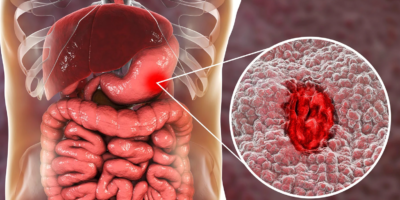The prostate is a walnut-size gland that encircles the urethra just below the bladder. Glandular tissue contributes fluid to the semen; muscles within the prostate help expel semen during ejaculation. Disorders of the prostate are relatively common. More than 30 million men suffer from prostate conditions, such as prostatitis, benign prostatic hyperplasia, and prostate cancer. Prostatitis (prostate inflammation) affects about half of the men sometime during their lifetime. The symptoms of acute bacterial prostatitis include frequent and painful urination, pain in the low back or behind the testicles, painful ejaculation, aching muscles, fever, chills, and fatigue. Benign prostatic hyperplasia, also called benign prostatic hypertrophy (BPH), affects mostly older men. About half of fifty- to sixty-year-old men develop BPH. Between ages eighty and ninety that proportion rises to nearly 90 percent. This noncancerous enlargement of the prostate encroaches on the urethra, decreasing the ability of urine to easily flow from the bladder. Symptoms include increased frequency and urgency of urination, nighttime urination, a weak urine stream, an inability to fully empty the bladder, and difficulty stopping and starting urination. The underlying cause is an age-related rise in prostate levels of dihydrotestosterone (DHT) as well as estrogen, which stimulates cells to multiply.


1. Salubrious Stir-Fried Veggies and Tofu
How it works: Traditional Asian diets are associated with a reduced likelihood of BPH and prostate cancer. These diets include regular consumption of vegetables, soy, and green tea, all of which contain substances that restrain prostate growth. On the other hand, diets high in fats, carbohydrates, and red meat seem to increase the risk.
- PREPARATION:
- 1 cup (248 g) firm tofu, cubed
- 1½ teaspoons (8 ml) soy sauce
- 3 tablespoons (45 ml) olive oil, divided
- 3 cups (400 g) combination of any of the following: chopped red bell pepper, asparagus, onion, broccoli, and mushrooms
- 3 garlic cloves, minced
- 1½ teaspoons (4 g) grated fresh ginger
- Freshly ground black pepper
- DIRECTIONS:
In a bowl, toss together tofu, soy sauce, and 1 tablespoon (15 ml) of olive oil.
Heat a skillet over medium-high and sauté the coated tofu for about 3 minutes until it begins to brown. Transfer the tofu to a bowl and set aside. Into the hot skillet place the remaining olive oil, veggies, garlic, and ginger. Sauté the mix for about 6 minutes. Add the tofu and combine it with the vegetables. Add black pepper to taste. Enjoy the veggies in a bowl or over brown rice.
- YIELD: 3 TO 4 SERVINGS
2. Super Tomatillo-Pumpkin Seed Salad Dressing
How it works: Pumpkin seeds contain healthy oil, fiber, carotenes (which are antioxidants and promote immune function), vitamin E, and zinc. Pumpkin seed oil extracts, with or without saw palmetto, can reduce BPH symptoms. Zinc seems to inhibit the proliferation of prostate cancer cells. Low zinc can occur in men with BPH and prostate cancer. Zinc is also needed for sperm production.
- PREPARATION:
- 1 can (13 ounces, or 368 g) tomatillos, drained
- ½ white onion, chopped
- ¼ cup (4 g) fresh cilantro leaves, chopped
- ½ cup (32 g) roasted pumpkin seeds
- 1 jalapeño pepper, seeded and chopped
- 1 garlic clove
- 1 tablespoon (15 ml) fresh lime juice
- Water
- Salt
- DIRECTIONS: Purée the tomatillos, onion, cilantro, pumpkin seeds, jalapeño, garlic, and lime juice in a blender until coarse. Pour in a bowl and add just enough water to give it a sauce-like consistency. Add salt to taste. Drizzle over broiled chicken or fish.
- YIELD: 04 SERVINGS
3. Green Tea for Guys
How it works: Habitual consumption of green tea correlates with reduced cancer risk. Lab studies show that green tea polyphenols impair the ability of prostate cancer cells to divide and trigger the death of these cells.
- PREPARATION:
- 2 green tea bags
- Handful of fresh mint
- Fresh lime juice
- Honey, to taste
- DIRECTIONS: Bring the water to a boil in a saucepan and then turn off the heat. Add the tea and mint and steep, covered, for about 10 minutes. Pour into cups, straining out the mint. Stir in the lime juice and honey. Enjoy hot or cold.
- YIELD: 02 SERVINGS
4. Powerful Pomegranate Smoothie
How it works: Pomegranate juice inhibits the development of prostate cancer and the progression of already existent prostate cancer. Compounds in pomegranate cause prostate cancer cells to die and decrease the migration of these cells. A study in men with prostate cancer resulted in none of the patients progressing to advanced stages while drinking 8 ounces (235 ml) of pomegranate juice a day. Pomegranate also slowed the rise in blood levels of PSA.
- PREPARATION:
- 2 cups (400 g) plain nonfat Greek yogurt
- 8 ounces (235 ml) pure pomegranate juice
- 1 banana, peeled, cut into chunks, and frozen
- ½ cup (128 g) sliced strawberries, frozen
- DIRECTIONS: Pour the yogurt and juice into a blender. Add the fruit and blend until smooth. Enjoy!
- YIELD: 02 SERVINGS
5. Broiled Tomatoes with Beneficial Garlic
How it works: Studies in the early part of the twenty-first century linked high intake of tomato products (and the lycopene they contain) with a lower risk of prostate cancer. A few years later, however, the correlation failed to hold up. Nevertheless, tomatoes and other plant foods contain a host of nutrients beneficial to health. One study found that garlic extracts improve urine flow in men with BPH and prostate cancer. Garlic also enhances immune function and has anti-prostate-cancer activity.
- PREPARATION:
- 3 large round tomatoes (not Roma or plum)
- 3 large garlic cloves
- 2 teaspoons (2 g) crushed dried thyme leaves
- Freshly ground black pepper
- ¼ cup (60 ml) olive oil
- 1 tablespoon (10 g) crushed garlic
- Warm, crusty loaf of whole-grain bread
- DIRECTIONS:
Preheat the oven to broil.
Cut each tomato in half across its equator. Place the tomato halves face up on a baking sheet. Slice the garlic cloves lengthwise to make six pieces and insert a piece into each of the tomatoes. Sprinkle each tomato half with thyme and pepper. Drizzle with oil. Broil for about 10 minutes. After broiling, dot the tomatoes with the crushed garlic (broiling tends to deactivate the benefits of the inserted garlic). Serve with warm, crusty bread.
- YIELD: 06 SERVINGS
- RECIPE VARIATION: For a more pizzalike dish, mash the soft, warm tomatoes over the sliced open loaf and top with ¼ cup (38 g) of goat cheese.
6. Antioxidant Orange Cranberry Muffins
How it works: Cranberry contains potent antioxidant and anti-inflammatory substances, which helps prevent bacterial urinary tract infections in women. One study found that dried, powdered cranberries (500 milligrams three times a day for six months) ameliorated symptoms in men with chronic nonbacterial prostatitis. A test-tube study found that cranberry extract inhibited the growth of human prostate cancer cells.
- PREPARATION:
- 2 cups (180 g) oat flour
- 2 teaspoons (9 g) baking powder
- 1 cup (110 g) chopped pecans or (120 g) walnuts
- 2 teaspoons (5 g) flaxseed meal
- ½ cup (120 ml) canola oil
- 1 cup (235 ml) fresh orange juice
- 3 tablespoons (60 g) honey or agave nectar
- 1 cup (120 g) coarsely chopped dried cranberries
- DIRECTIONS:
Preheat the oven to 350°F (180°C, or gas mark 4).
Grease a twelve-compartment muffin tin or line it with paper liners.
In a large bowl, mix the oat flour, baking powder, pecans, and flaxseed meal. Pour the oil, orange juice, and honey into the flour mixture and stir until just moistened. Fold in the cranberries. Do not overmix. Spoon the batter into the prepared muffin tin. Bake for about 25 minutes, or until a toothpick inserted into the center of a muffin comes out clean. Transfer the muffin tin to a cooling rack and cool for 5 minutes.
- YIELD: 10 TO 12 MUFFINS
7. The Big Q Baked Onion
How it works: Quercetin—an antioxidant found in many plants—and other flavonoids seem to protect against several cancers, including prostate cancer. In one study, supplemental quercetin (500 milligrams twice daily for one month) reduced symptoms of chronic nonbacterial prostatitis. In onions, the quercetin is concentrated in the skin, so keep the skin intact while baking and remove afterward. In addition to onions, quercetin comes in flavonoid-rich fruits, such as grapes, dark cherries, blackberries, bilberries, and blueberries.
- PREPARATION:
- 2 Vidalia onions
- Olive oil
- ¼ cup (7 g) whole fresh rosemary leaves
- Freshly ground black pepper
- DIRECTIONS:
Preheat the oven to 350°F (180°C, or gas mark 4).
Place two squares of aluminum foil, each large enough to wrap an onion, on a baking sheet. Leave the skins on the Vidalias and cut out the stems, making an indentation about an inch (2.5 cm) deep and wide on each onion. Place each onion on a foil square. Baste each onion indentation with olive oil. Sprinkle pepper into the indentation and fill it with whole rosemary leaves. Enclose each onion in the foil and pinch the top together. Bake for about 1 hour. The onions should be tender and easy to pierce with a fork. Remove them from the aluminum foil and peel before serving.
- YIELD: 2 TO 4 SERVINGS
Fact or Myth?
- MEN WHO TAKE SUPPLEMENTS OF BETA-CAROTENE ENJOY A DECREASED RISK OF PROSTATE CANCER. Myth. Initial studies indicated a protective effect for a different carotene, lycopene. However, subsequent studies yielded mixed results, with either some protection or no effect. Beta-carotene supplements, however, may actually increase the risk. Vitamin E supplements have also been linked to an increased risk of prostate cancer.
Lifestyle Tip
- Seek social support. Friends and family help us weather life’s challenges. Support can be particularly important when undergoing cancer treatment.
- Sleep at night. Working the night shift has been linked to an increase in prostate cancer, as well as breast cancer. Exposure to lights at night drives down melatonin, a hormone that regulates daily rhythms, acts as an antioxidant, promotes immune function, and may have direct anti-cancer effects. A study found that taking melatonin supplements with conventional treatment further decreased some markers of prostate cancer. (Note: Melatonin might counteract some chemotherapeutic drugs. Don’t self-medicate without checking with your doctor.)
- Avoid tobacco smoke. It causes cancer in multiple organ systems.
- Follow a whole-foods diet—one high in vegetables and fruits with moderate intake of animal foods. In addition to age and family history, other risk factors for developing BPH include diabetes, obesity, high blood pressure, or heart disease. Consuming lots of carbohydrates (especially refined carbohydrates and added sugar) and fats is also a risk. In general, excessive calorie intake promotes unhealthy weight gain, elevated blood sugar levels, and resistance to the actions of insulin (the hormone that stimulates sugar to enter cells), which causes insulin levels to rise. Insulin seems to promote prostatic growth.
- Catch some rays. Prostate cancer is more common at higher latitudes, where the skin produces no vitamin d in response to UV radiation during the winter months. Lower levels of vitamin d may also explain why black men are more at risk for aggressive prostate cancer than are white men (who require less Uv exposure to make vitamin D). If you’re thinking of taking vitamin d supplements, talk to your doctor first.
When to Call the Doctor
- You have symptoms of prostatitis. Fever, chills, and nausea are associated with acute bacterial prostatitis. Chronic bacterial prostatitis can cause blood in semen or urine.
- You have symptoms of BPH: frequent and painful urination, pain in the low back, pelvis, or behind the testicles, painful ejaculation, aching muscles, fever, chills, and fatigue. Get a proper diagnosis, even if you want to try a dietary supplement such as saw palmetto. Symptoms of BPH can overlap with those of prostate cancer.
- You develop trouble urinating, blood in urine or semen, discomfort in the pelvic area, or bone pain.
- Discuss screening tests for prostate cancer with your doctor.






Leave a Reply